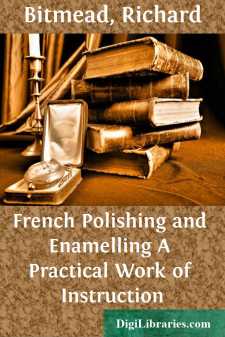Categories
- Antiques & Collectibles 13
- Architecture 36
- Art 48
- Bibles 22
- Biography & Autobiography 813
- Body, Mind & Spirit 142
- Business & Economics 28
- Children's Books 14
- Children's Fiction 11
- Computers 4
- Cooking 94
- Crafts & Hobbies 4
- Drama 346
- Education 46
- Family & Relationships 57
- Fiction 11828
- Games 19
- Gardening 17
- Health & Fitness 34
- History 1377
- House & Home 1
- Humor 147
- Juvenile Fiction 1873
- Juvenile Nonfiction 202
- Language Arts & Disciplines 88
- Law 16
- Literary Collections 686
- Literary Criticism 179
- Mathematics 13
- Medical 41
- Music 40
- Nature 179
- Non-Classifiable 1768
- Performing Arts 7
- Periodicals 1453
- Philosophy 64
- Photography 2
- Poetry 896
- Political Science 203
- Psychology 42
- Reference 154
- Religion 513
- Science 126
- Self-Help 84
- Social Science 81
- Sports & Recreation 34
- Study Aids 3
- Technology & Engineering 59
- Transportation 23
- Travel 463
- True Crime 29
French Polishing and Enamelling A Practical Work of Instruction
by: Richard Bitmead
Categories:
Description:
Excerpt
CHAPTER I.
THE IMPROVING AND PREPARATION OF FURNITURE WOODS.
For a French polisher to be considered a good workman he should, in addition to his ordinary ability to lay on a good polish, possess considerable knowledge of the various kinds of wood used for furniture, as well as the most approved method of bringing out to the fullest extent their natural tones or tints; he should also be able to improve the inferior kinds of wood, and to stain, bleach, or match any of the fancy materials to which his art is applied, in a manner that will produce the greatest perfection. The following information is given to facilitate a thorough knowledge of the above processes.
Improving.—Iron filings added to a decoction of gall-nuts and vinegar will give to ebony which has been discoloured an intense black, after brushing over once or twice. Walnut or poor-coloured rosewood can be improved by boiling half an ounce of walnut-shell extract and the same quantity of catechu in a quart of soft-water, and applying with a sponge. Half a pound of walnut husks and a like quantity of oak bark boiled in half a gallon of water will produce much the same result. Common mahogany can be improved by rubbing it with powdered red-chalk (ruddle) and a woollen rag, or by first wiping the surface with liquid ammonia, and red-oiling afterwards. For a rich mild red colour, rectified spirits of naphtha, dyed with camwood dust, or an oily decoction of alkanet-root. Methylated spirits and a small quantity of dragon's blood will also produce a mild red. Any yellow wood can be improved by an alcoholic solution of Persian berries, fustic, turmeric, or gamboge. An aqueous decoction of barberry-root will serve the same purpose. Birch when preferred a warm tint may be sponged with oil, very slightly tinted with rose-madder or Venetian red; the greatest care should be used, or it will be rendered unnatural in appearance by becoming too red. Maple which is of a dirty-brown colour, or of a cold grey tint, and mahogany, ash, oak, or any of the light-coloured woods, can be whitened by the bleaching fluid (see "Matching"). Numerous materials may be improved by the aid of raw linseed-oil mixed with a little spirits of turpentine. Artificial graining may be given to various woods by means of a camel-hair pencil and raw oil; two or three coats should be given, and after standing for some time the ground should have one coat of oil much diluted with spirits of turpentine, and then rubbed off.
Matching.—Old mahogany furniture which has been repaired may be easily matched by wiping over the new portions with water in which a nodule of lime has been dissolved, or by common soda and water. The darkeners for general use are dyed oils, logwood, aquafortis, sulphate of iron, and nitrate of silver, with exposure to the sun's rays. For new furniture in oak, ash, maple, etc., the process of matching requires care and skill. When it is desirable to render all the parts in a piece of furniture of one uniform tone or tint, bleach the dark parts with a solution of oxalic acid dissolved in hot water (about two-pennyworth of acid to half a pint of water is a powerful solution); when dry, if this should not be sufficient, apply the white stain (see pp. , ) delicately toned down, or the light parts may be oiled. For preserving the intermediate tones, coat them with white polish by means of a camel-hair pencil. On numerous woods, carbonate of soda and bichromate of potash are very effective as darkeners, as are also other preparations of an acid or alkaline nature, but the two given above are the best.
A good way of preparing these darkeners, says the "French Polisher's Manual," an excellent little work published in Perth some years since, is to procure twopennyworth of carbonate of soda in powder, and dissolve it in half a pint of boiling water; then have ready three bottles, and label them one, two, three....


